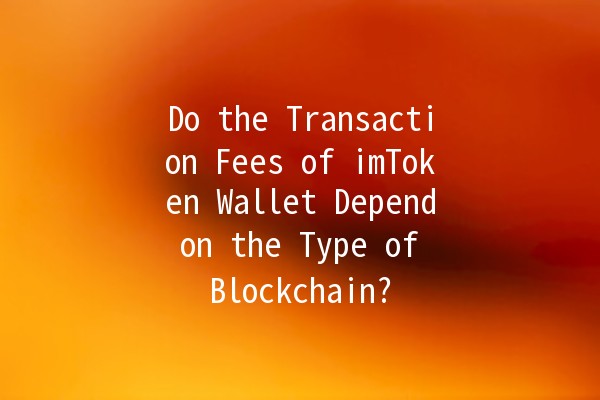In the dynamic landscape of cryptocurrencies, transaction fees have become a critical consideration for users, particularly for those employing wallets like imToken. Understanding whether these fees are influenced by the type of blockchain used is essential for informed decisionmaking. This article dives deep into the relationship between transaction fees and blockchain types while giving practical insights and tips for users looking to optimize their experience with imToken.
imToken is a popular cryptocurrency wallet that supports multiple blockchain assets, including Ethereum and Bitcoin. Its userfriendly interface and robust features make it an appealing choice for both beginners and experienced users. With features such as decentralized exchange (DEX) functionalities and builtin token swap capabilities, imToken simplifies the management of multiple cryptocurrencies.
Transaction fees, in the context of blockchain technology, can be defined as the costs associated with processing and confirming transactions on the network. These fees are paid to miners or validators who maintain the security and integrity of the blockchain. Users often incur these fees when transferring assets, engaging in smart contracts, or executing trades on DEX platforms.
Different blockchains have varying consensus mechanisms and transaction processing capacities. This divergence significantly affects transaction speeds, scalability, and fees. Here’s how various blockchain types can influence the transaction fees associated with imToken:
Example: Bitcoin, Ethereum (currently transitioning to Proof of Stake)

Transaction Fees: On PoW networks, transaction fees can fluctuate dramatically based on demand. When many users initiate transactions, miners prioritize those with higher fees, leading to increased costs during peak times.
Optimization Tip: Users should consider timing their transactions when network congestion is low to minimize fees.
Example: The new Ethereum model posttransition, Cardano
Transaction Fees: PoS networks often exhibit lower fees and quicker transaction times. They handle higher volumes of transactions more efficiently than PoW.
Optimization Tip: Use wallets that operate primarily on PoS networks for lower fees and quicker confirmations.
Examples: Polygon, Optimism
Transaction Fees: Layer 2 solutions are designed to ease congestion on main blockchains, offering significantly lower fees. Transactions can be bundled together, reducing costs for users.
Optimization Tip: Consider using Layer 2 solutions compatible with imToken to save on fees while ensuring faster transactions.
Example: Delegated Proof of Stake (DPoS) used by EOS
Transaction Fees: DPoS provides an efficient way to validate transactions, resulting in consistently lower fees due to fewer participants required for consensus.
Optimization Tip: Engage with blockchains that utilize these alternative consensus methods for enhanced transaction efficiency and costeffectiveness.
Public Blockchains: These are open and accessible to all, which could lead to higher fees during peak usage times.
Private Blockchains: Generally have more predictable and lower fees due to limited participant access and controlled transaction volumes.
Optimization Tip: Choose private blockchain options for transactional activities that require predictability and reduced fees.
Understanding the influence of blockchain types on transaction fees can empower users to make educated choices regarding the assets they hold and the transactions they initiate within the imToken ecosystem. The following strategies can help users minimize fees effectively:
The transaction fees on imToken are determined by several factors including the type of blockchain used (PoW vs. PoS), current network conditions, and the transaction size. During high network congestion, fees can increase significantly, so users should monitor activity levels.
Yes, imToken provides users with options to customize transaction fees. Users can select their preferred fee tier, which may impact transaction speed and confirmation times.
While imToken is a versatile wallet, users may find alternatives with lower fees based on the blockchain type they wish to use. It's beneficial to compare wallets and their fee structures for specific cryptocurrencies.
To reduce fees, consider transacting with cryptocurrencies that utilize PoS or Layer 2 solutions, monitor network congestion, select appropriate times to transact, and adjust fees manually based on urgency.
Transaction fees vary due to different consensus mechanisms, transaction processing efficiencies, and overall network demand. PoW blockchains tend to have more variable fees compared to the more stable fees of some PoS and DPoS networks.
Users can utilize analytical tools or historical data tracking on network activity to make educated guesses about when transaction fees may drop. Engaging with online communities can also provide insights into better timing for transactions.
Transaction fees in the imToken wallet are intricately tied to the types of blockchains used. By understanding how different factors influence these fees, users can adopt strategies to optimize their transactions, saving both time and money. Staying informed, monitoring network conditions, and leveraging the appropriate blockchain technologies will enhance user experiences and outcomes within the rapidly evolving cryptocurrency space.